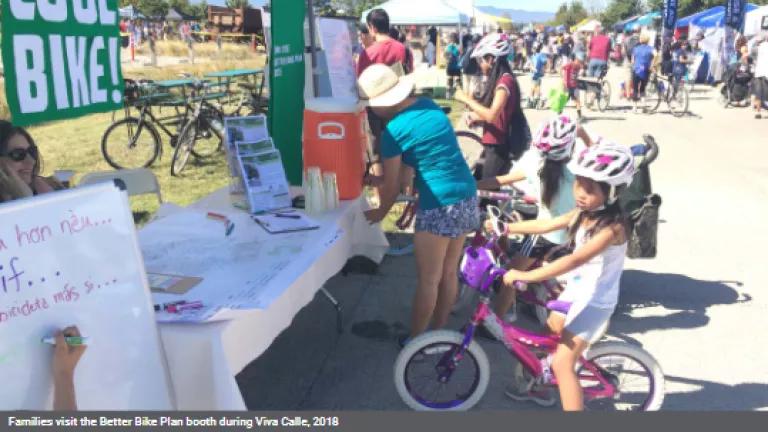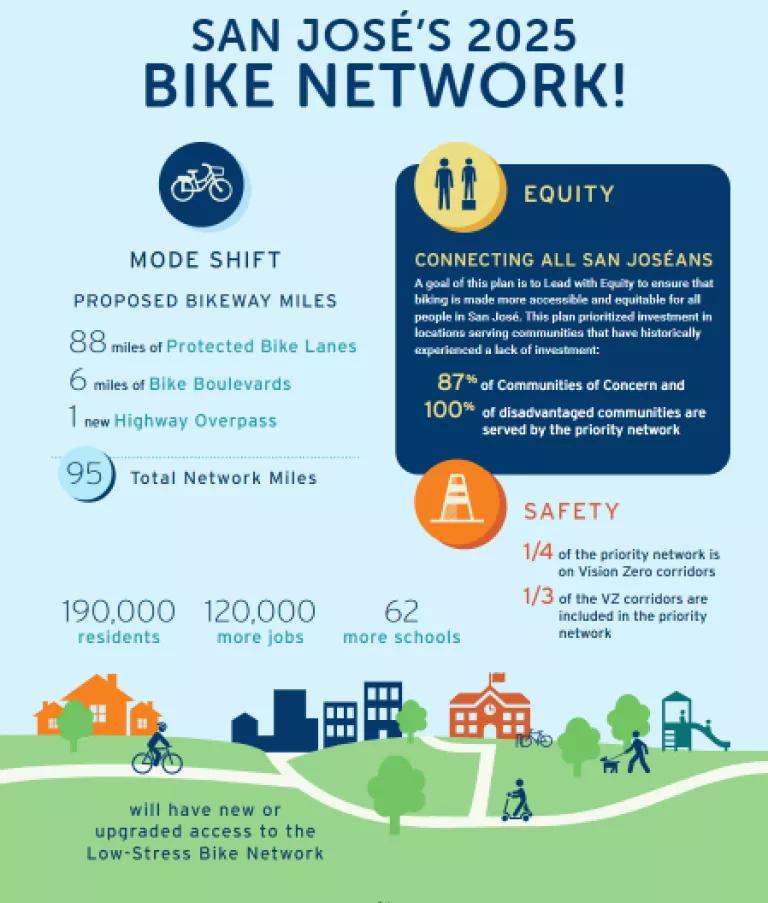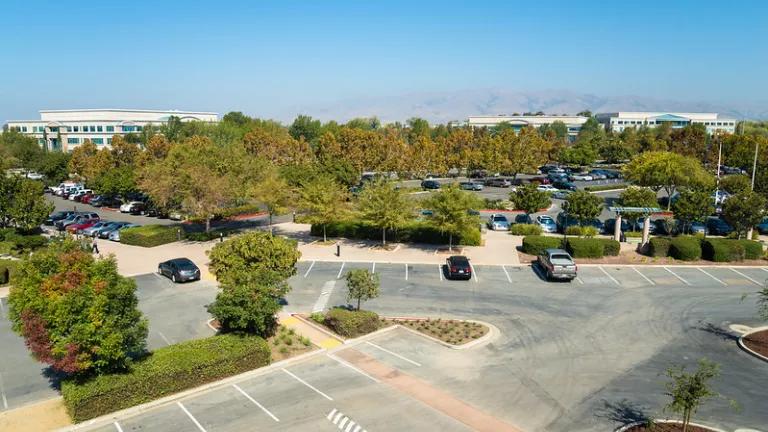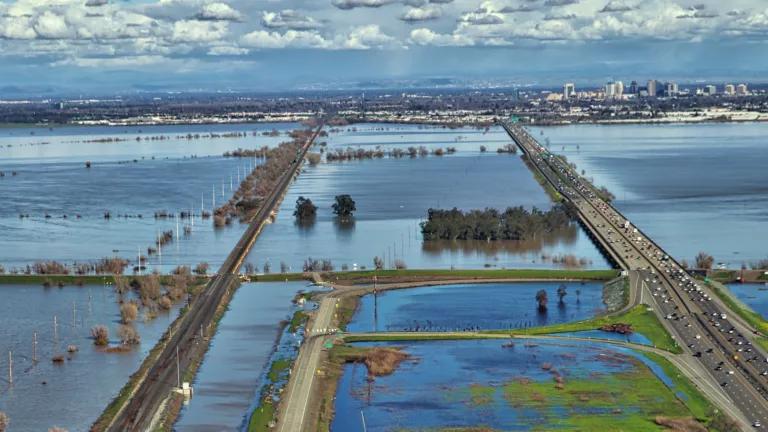San Jose’s Bold New Plan for Climate-Friendly Transportation
San Jose has adopted a bold new plan to help residents get around this famously sprawling city in ways that are low-cost, low-carbon—and now, safe and fun.

San Jose is rolling out the green carpet for biking, thanks to the City Council’s unanimous passage today of the Better Bike Plan 2025. With the plan’s adoption, the City commits to building a 550-mile network of bike lanes, boulevards, and trails to help thousands more people ride safely.
The plan is realistic about the past, acknowledging San Jose’s sprawling 180-square-mile spread, its car-oriented layout, and its inequitable history of transportation decisions, which continue to shape people’s lives today. But the plan also looks ahead, aiming to create a city where anyone can comfortably bike to any neighborhood.
The planned network includes 350+ miles of protected bike lanes, 100 miles of bike boulevards, and 100 miles of off-street trails. Already, the city has built over 390 miles total.
First, make it safe
The numbers are impressive. But the numbers don’t tell the whole story.
With this plan, and its creation, the City lays out a thoughtful approach to who feels comfortable biking, who doesn’t, and how to invite more people out onto bikes.
For too long, bike lanes—not just in San Jose but nationally—have been created for the few people who feel fine biking on a street full of fast traffic, protected by only a line of white paint. The new plan acknowledges that’s often not enough for people to feel comfortable, instead offering “the evolution of a bike lane,” first by just widening that painted lane into buffer to create more separation from traffic, then putting parked cars between bikes and traffic when possible, and then building a whole raised curb between cars and the bike lane. So sometimes, instead of adding miles, it's important to go back and make existing miles of bike lanes better and safer. The plan emphasizes that many of San José’s quiet residential streets can together connect to create a “low-stress” network of “bike boulevards,” along with safe ways to get across the big busy streets.
To create the plan, City staff talked with residents. They also partnered with community-based organizations like Veggielution, LUNA (Latinos United for a New America), and VIVO (Vietnamese Voluntary Foundation). At meetings and focus groups in Spanish and Vietnamese as well as English, City staff and partners asked residents: What would help make them more likely to bike?
Paramount across communities was concern for safety.
Build quick, aim high
The City has already shown that it can move quickly. With its Better Bikeways project and with the assistance of the Bloomberg Philanthropies American Cities Climate Challenge, from 2018 to 2020, San Jose will have built 15 miles of protected bike lanes.
The “quick-build” model is impressive. A few of us from the Climate Challenge got to tour San Jose’s downtown by bike last year with Mayor Liccardo and the National Association of City Transportation Officials (NACTO). We pedaled along new green lanes, protected by sturdy green posts and complete with ingenious bus islands that are wheelchair-accessible and allow bus riders to cross bike lanes safely. The green posts that protect bikers look reassuringly solid but they’re actually plastic, making them low-cost, easy to install, and yet imposing enough to form a kind of low wall between bikes and car traffic. It felt safe.
Now the trick is to build out from downtown, connect to neighborhoods, and get more people using them.
The City has set ambitious goals for “bike mode share,” which means the percentage of all the trips people take in the city that are by bicycle. San Jose’s current General Plan aims for 15% bike commute mode share by 2040, and its Climate Smart plan seeks to reach 20% by 2050.
These are tall orders. Today, just 1% of commute trips in the city are made by bike, though a City survey found that 3% of people reported biking as their primary way of getting to work and even more residents using a bike as a backup mode of transportation. Of commute trips to downtown, 4% are by bike. These numbers might sound small, but it’s important to consider that bike commuting is on the rise: between 1990 and 2017, San Jose saw a 28% increase in commute trips made by bike.
But not all trips are commute trips; in fact, in San Jose, only one in five trips are to and from work. That’s especially true in these teleworking times. Encouragingly, the plan notes that 60% of all trips people make in the city are less than three miles long. Those short trips, combined with the city’s mild climate and flat terrain, make biking a good option, creating the opportunity for the City to achieve its bold goals.
The Better Bike Plan 2025 includes a five-year action plan of prioritized projects to implement and coordinates with the City’s paving program to save money. It offers a range of costs to make these changes, from quick and temporary to more permanent, that total roughly $300 million.
The prioritized projects listed in the plan—the list of streets where bike improvements will go—were chosen with three aims:
- Increase biking mode share: Areas where bicycle trips are most likely, based on factors like population, employment, and connections to transit, downtown, and the existing bike lane network.
- Increase safety: Projects that will fix “high-injury” streets where collisions are most serious and frequent.
- Increase equity: Low-income and historically underserved neighborhoods, also called “Communities of Concern,” especially just to the south, east, and north of downtown. People living in these neighborhoods are likely to have fewer transportation options, less access to a private car, and may be essential workers, required to show up at a job in person every day. More safe, healthy, affordable transportation options are needed, and soon.

What comes next: a time for action
In this difficult year, many cities have been finding creative ways to help their residents get around in ways that are safe, healthy, and affordable. Biking nationally has boomed. San José has launched an Al Fresco program that repurposes streets for outdoor dining.
In March 2020, nearby Oakland launched the nation’s first and most ambitious “Open Streets” program along its planned bike network, acting quickly to make those streets safer by discouraging most car traffic. Oakland’s Open Streets program also creates more safe outdoor areas for people in neighborhoods with less access to open space, reduces crowding at Lake Merritt and other parks, and frees up more space for social distancing than sidewalks typically offer. Oakland recently released a report to help cities in the Bay Area and beyond learn from its example.
San José has a less dense footprint than Oakland, but its residents still have a great need for safe, affordable transportation in these times. The City can now take its thoughtful Better Bike Plan as a starting point to act quickly, and rebuild its streets to bring safe biking to all.



